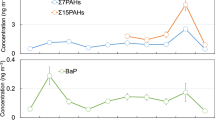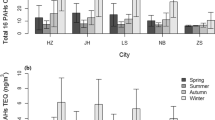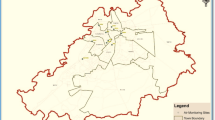Abstract
All available polycyclic aromatic hydrocarbon (PAH) concentration data in ambient air obtained over the past 10 years in Germany were evaluated to clarify whether it is justified to use benzo(a)pyrene (BaP) as a marker compound for the total PAH exposure. The data basis comprises annual mean concentrations from 1990 to 1998 supplied by the emission protection authorities of the federal states with additional information on the region, year and site of measurement. The data are very heterogeneous with respect to sample size, the number of individual PAHs analyzed, place of origin and year. Nine of 25 individual compounds with sufficient sample size (74<N<518) were submitted to an explorative descriptive analysis and multiple regression analysis. Six compounds were selected for factor analysis to evaluate whether associations can be related to one or several background determinants. The concentration data of BaA, BeP, BaP, DBA, BghiP, COR, BbF, BkF and INP are not normally distributed and demonstrate great variability. Location, East–West differences persisting after the German reunion and time characterize the distributive patterns, e.g., from 1991 to 1997, a significant decrease in BaP could be determined based on the data from North Rhine-Westphalia (1991, N=51, median 1.6 ng/m3; 1997, N=45, median 0.7 ng/m3; P≤0.0001). The BaP concentrations in the new federal states in the East (N=80, median 2.2 ng/m3) are about twice as high compared to the ones in the old federal states in the West (N=438, median 1.1 ng/m3; P≤0.0001). BaP measurements taken at sites characterized by traffic (1.8 ng/m3), industrial (1.3 ng/m3) or urban environment (1.3 ng/m3) rank significantly higher compared to measurements taken at rural sites (0.92 ng/m3; P≤0.0001). Factor analysis of the intercorrelation matrix of BaA, BeP, BaP, DBA, BghiP and COR yields one factor to explain 92% of the variability of the six individual PAHs. BaP shows the highest factor loading. These results confirm the common practice to use BaP as marker compound for the PAH exposure in ambient air.
This is a preview of subscription content, access via your institution
Access options
Subscribe to this journal
Receive 6 print issues and online access
$259.00 per year
only $43.17 per issue
Buy this article
- Purchase on Springer Link
- Instant access to full article PDF
Prices may be subject to local taxes which are calculated during checkout





Similar content being viewed by others
References
Brosius G Brosius F, 1995 SPSS Base System and Professional Statistics. International Thomson Publishing, Bonn 1995
deRaat WK de Meijere FA Polycyclic aromatic hydrocarbon (PAH) concentrations in ambient airborne particles from local traffic and distant sources; variation of the PAH profile, Sci Total Environ (1995) 103(1): 1–17
Fertmann R Tesseraux I Schümann M Neus H Prinz B, 1999. Auswertung der in der BRD vorliegenden Immissionsmessdaten von polyzyklischen aromatischen Kohlenwasserstoffen (1990–1998), Bericht im Auftrag des Unterausschusses Wirkungsfragen des Länderausschusses für Immissionsschutz (LAI), Hamburg (1999)
Gladtke D Air pollution in the Rhine-Ruhr area, Toxicol Lett (1998) 96: 277–283
Grimmer G Vergleich der PAH-Profile aus Umweltproben, VDI Report 358. VDI-Verlag, Düsseldorf 1980 39–50
Heudorf U Schubert W Innenraumbelastung mit polycyclischen aromatischen Kohlenwasserstoffen (PAK) durch PAK-haltige Parkettklebstoffe-Hinweise der Projektgruppe Schadstoffe der Bauministerkonferenz, Umweltmed Forsch Prax (2000) 5: 341–344
International Agency for Research on Cancer (IARC) 1987. Overall evaluation of carcinogenicity. An updating of IARC Monographs Volumes 1 to 42, IARC Monogr Eval Carcinog Risk Man Suppl 7. Lyon, France 1987
IPCS International Program on Chemical Safety Selected Non-Heterocyclic Polycyclic Aromatic Hydrocarbons, Environmental Health Criteria 202. WHO (World Health Organization), Geneva 1998
Kleinbaum DG Kupper LL Muller KM Applied Regression Analysis and Other Multivariable Methods 2nd EdPWS-KENT Publishing, Boston 1988
Lighty JS Veranth JM Sarofim AF Combustion aerosols: factors governing their size and composition and implications to human health, J Air Waste Manage Assoc (2000) 50(9): 1565–1622
Mackay D Hickie B Mass balance model of source apportionment, transport and fate of PAHs in Lac Saint Louis, Quebec, Chemosphere (2000) 41(5): 681–692
Menichini E Urban air pollution by polycyclic aromatic hydrocarbons: levels and sources of variability, Sci Total Environ (1992) 116: 109–135
Nisbet ICT LaGoy PK Toxic equivalency factors (TEFs) for polycyclic aromatic hydrocarbons (PAH), Regul Toxicol Pharmacol (1992) 16: 290–300
Petry T Schmid P Schlatter C The use of toxic equivalency factors in assessing occupational and environmental health risks associated with exposure to airborne mixtures of polycyclic aromatic hydrocarbons (PAH), Chemosphere (1996) 32: 639–684
Pott F Pyrolyseabgase, Profile von polycyclischen aromatischen Kohlenwasserstoffen und Lungenkrebsrisiko-Daten und Bewertung, Staub-Reinhalt Luft (1985) 45: 369–379
Prinz B Stratmann H Anwendungsmöglichkeiten der Faktorenanalyse bei Immissionsuntersuchungen, Staub-Reinhalt Luft (1968) 28: 25–30
United States Environmental Protection Agency (USEPA). Provisional Guidance for Quantitative Risk Assessment for Polycyclic Aromatic Hydrocarbons (1993) EPA/600/R-93/089
VDI Guideline 3875 Outdoor-air pollution measurement. Indoor air pollution measurement. Measurement of polycyclic aromatic hydrocarbons (PAH). Gas chromatographic determination. Sheet 1, VDI (1996)
World Health Organization (WHO) Air quality guidelines for Europe. WHO regional publications European series, no. 23WHO Regional Office for Europe, Copenhagen 1987
World Health Organization (WHO) Updating and Revision of the Air Quality Guidelines for Europe, Brussels, Belgium, October 2–6 (1995)
World Health Organization (WHO) Guidelines for drinking-water quality, Addendum to Volume 2 “Health criteria and other supporting information” 1998 WHO/EOS/98.1
Acknowledgements
The authors thank H. Blunck and M. Wessel for their technical assistance and the anonymous reviewers for their valuable suggestions.
Author information
Authors and Affiliations
Corresponding author
Rights and permissions
About this article
Cite this article
FERTMANN, R., TESSERAUX, I., SCHÜMANN, M. et al. Evaluation of ambient air concentrations of polycyclic aromatic hydrocarbons in Germany from 1990 to 1998. J Expo Sci Environ Epidemiol 12, 115–123 (2002). https://doi.org/10.1038/sj.jea.7500206
Received:
Published:
Issue Date:
DOI: https://doi.org/10.1038/sj.jea.7500206
Keywords
This article is cited by
-
Determination of polycyclic aromatic hydrocarbons in the soil, atmospheric deposition and biomonitor samples in the Meric-Ergene River Basin, Turkey
Environment, Development and Sustainability (2020)
-
Potential sources and meteorological factors affecting PM2.5-bound polycyclic aromatic hydrocarbon levels in six main cities of northeastern Italy: an assessment of the related carcinogenic and mutagenic risks
Environmental Science and Pollution Research (2018)
-
Particle-phase concentrations of polycyclic aromatic hydrocarbons in ambient air of rural residential areas in southern Germany
Air Quality, Atmosphere & Health (2010)
-
Residential environmental exposures and other characteristics associated with detectable PAH-DNA adducts in peripheral mononuclear cells in a population-based sample of adult females
Journal of Exposure Science & Environmental Epidemiology (2005)



